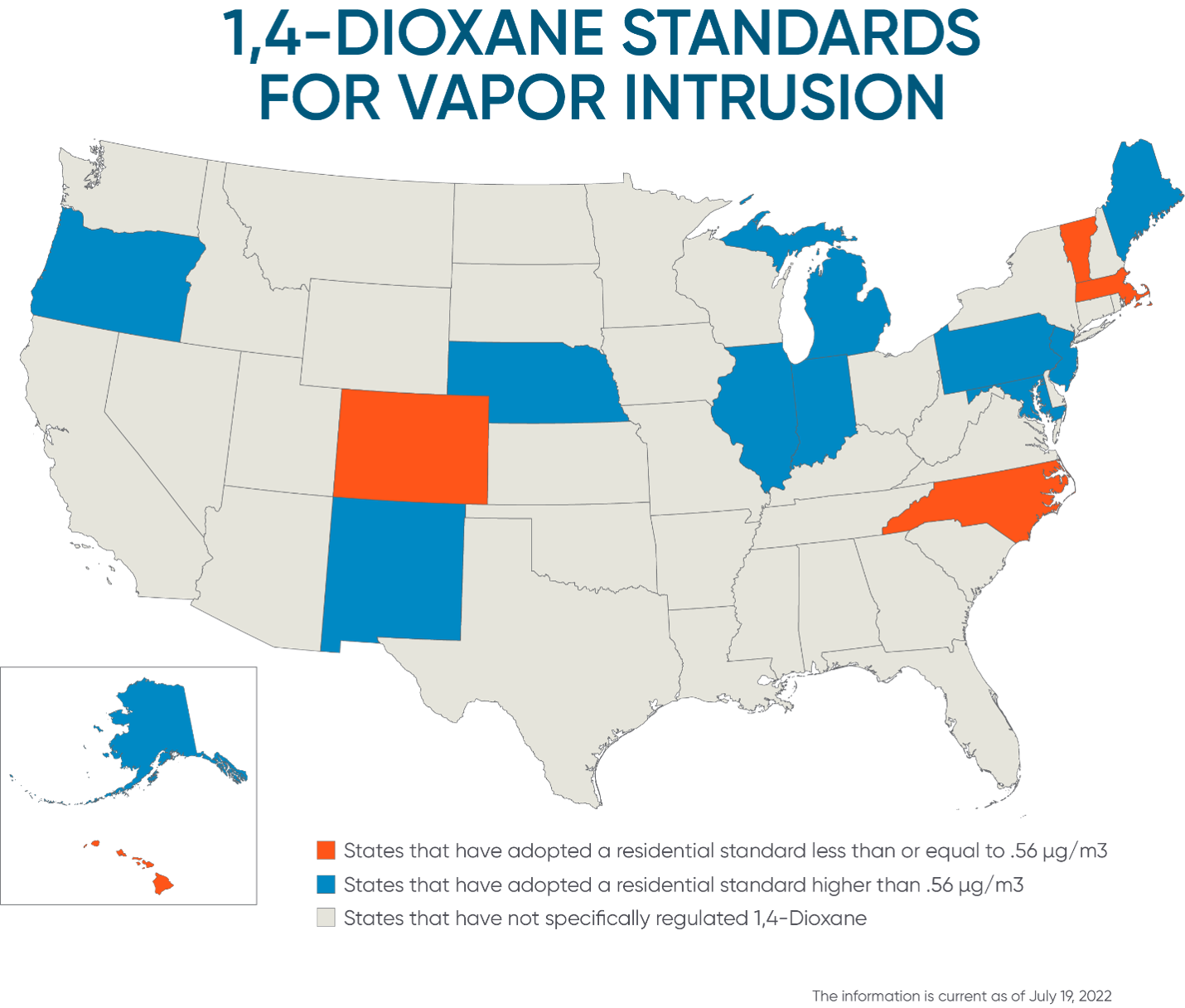Insights
1,4-Dioxane: The Latest Emerging Vapor Intrusion Issue
Jul 21, 20221,4-Dioxane is an emerging contaminant. Like “traditional” volatile organic compounds, it has the potential to volatilize and enter indoor air. This article explores why businesses should consider conducting a VI assessment when evaluating 1,4-Dioxane releases for site investigations or real property due diligence.
For additional background regarding 1,4-Dioxane, please refer to BCLP’s prior Client Alert, which discusses how this chemical has been used in certain products and industries.
I. Why 1,4-Dioxane is a Concern
According to the U.S. Environmental Protection Agency (“EPA”), 1,4-Dioxane moves rapidly from soil to groundwater. This factor is an important consideration because VI issues arise when contaminants appear beneath a building and vaporize into indoor air within the building.
EPA and many state agencies have determined that 1,4-Dioxane is a health risk to human beings at certain concentrations, although it is not listed as a known human carcinogen at this time. Studies used by EPA and the National Library of Medicine have determined that 1,4-Dioxane causes cancer in animals. Below is a summary of current agency conclusions as to human health:
Agency |
Conclusion |
|
EPA |
|
|
International Agency for Research on Cancer |
|
|
Agency for Toxic Substances and Disease Registry (”ATSDR”) |
|
|
Department of Health and Human Services |
II. 1,4-Dioxane and VI Issues
A VI issue of concern occurs when contaminated gases in the subsurface intrude into a building’s indoor air at concentrations that approach or exceed health benchmarks. In 2016, EPA established advisory Vapor Intrusion Screening Levels (“VISL”) for hundreds of chemicals, including 1,4-dioxane.
1,4-Dioxane is a potential concern at industrial facilities with groundwater contaminated with 1,4-Dioxane. But VI problems can be particularly acute as a result of the migration of contamination beneath residences, schools, or other sensitive uses. Risks are heightened if the contaminated plume is shallow or results in standing water in residential basements. According to a 2022 article addressing this issue:
Vapor Intrusion (VI) poses significant environmental problems that can degrade indoor air and pose human health risks. … 1,4-Dioxane [is] a widely used volatile organic compound (VOC) that is found in groundwater, however, this compound has not received much attention in indoor air and measurement methods are not well developed.
Importantly, VI issues have caused a number of seemingly finalized sites to be reopened. Both the ATSDR and EPA have issued VI guidance, in part to respond to these situations. This underscores how important VI issues can be in evaluating 1,4-Dioxane releases.
III. State Regulations
The federal government has not yet issued an enforceable standard for 1,4-Dioxane in drinking water, much less for VI.
As conveyed in the chart below, some States have established 1,4-Dioxane VI regulations or standards even absent federal guidance. These State initiatives seek to limit indoor air exposure issues based on different residential, industrial, or occupational standards.
This map and the information below is current as of July 19, 2022.

|
State |
State Agency Action |
State Indoor Air Standards |
|
Colorado |
Colorado Department of Public Health & Environment uses EPA Regional Screening Levels |
Regional Screening Level Ambient Air Standards: Residential: 0.56 ug/m3 Industrial: 2.5 ug/m3 |
|
Hawaii |
See Table C: Indoor Air and Soil Vapor Environmental Action Levels |
Indoor Action Levels: Residential: 0.56 ug/m3 Commercial: 2.5 ug/m3 |
|
Massachusetts |
Massachusetts Department of Environmental Protection Vapor Intrusion Guidance See Tables I-A (Residential) and I-B (Commercial/Industrial) |
Indoor Air Threshold Values: Residential: 0.47 ug/m3 Commercial: 2.3 ug/m3 |
|
North Carolina |
North Carolina Department of Environmental Quality Residential Vapor Intrusion Screening Levels Note: In March 2018, North Carolina Department of the Environment published the Vapor Intrusion Guidance
|
Indoor Air Screening Levels: Residential: 0.56 ug/m3 |
|
Vermont |
Investigation and Remediation of Contaminated Properties Rule See Appendix A: EPA’s Regional Air Screening Levels Note: In March of 2020, the Vermont Department of Environmental Conservation published the Vapor Intrusion Guidance
|
Regional Air Screening Levels: Residential: 0.56 ug/m3 Industrial: 2.5 ug/m3 |
|
Alaska |
See Appendix D Note: This is VI Guidance for Contaminated Sites only |
Target Levels for Indoor Air Residential: 5.6 ug/m3 Commercial: 25 ug/m3 |
|
Indiana |
See pg. 6 |
Vapor Exposure -- Indoor Air: Residential: 5.6 ug/m3 Commercial/Industrial: 25 ug/m3 |
|
Illinois |
Administrative Code, Illinois EPA VI Information, and Illinois Pollution Control Board Notice of Amendments See Table G of the third document: Soil Gas Remediation Objectives Note: The information listed above is for p-Dioxane |
Soil Gas Remediation Objectives: Residential: 16 ug/m3 Industrial/Commercial: 30 ug/m3 Construction Worker: 42 ug/m3 |
|
Maine |
See pg. 52 |
Remedial Action Guidelines, Indoor Air: Residential: 5.6 ug/m3 Commercial: 25 ug/m3 |
|
Maryland |
Maryland Department of the Environment Technical Guidelines for Vapor Intrusion See Table 1: Residential; and Table 2: Commercial |
Indoor Air Levels: Residential: 4.9 ug/m3 Commercial: 25 ug/m3 |
|
Michigan |
Guidance Document for the Vapor Intrusion Pathway See Appendix D-3: Indoor Air Interim Action Screening Levels |
Soil Vapor Screening Levels: Residential: 170 ug/m3 Nonresidential: 400 ug/m3 |
|
Nebraska |
Nebraska Department of Environment and Energy Voluntary Cleanup Program Remedial Goal See Table A-2: Soil Gas Vapor Intrusion Remediation Goals Note: This is VI Guidance for the Voluntary Remediation Program only |
Soil Gas Vapor Intrusion Remediation Goals: Residential: 19 ug/m3 Industrial: 820 ug/m3 |
|
New Jersey |
N.J.A.C. 7:26D Remediation Standards See Tables 7 (Residential) and 8 (Nonresidential): Indoor Air Remediation Standards for the Vapor Intrusion Exposure Pathway Note: In May 2021, New Jersey Department of Environmental Protection published the Vapor Intrusion Technical Guidance |
Indoor Air Remediation Standards: Residential: 0.72 ug/m3 Nonresidential: 2.5 ug/m3 |
|
New Mexico |
Vapor Intrusion Screening Levels See Table A-4: Vapor Intrusion Screening Levels (June 2022, Volume I, pg. A-28) |
Vapor Intrusion Screening Levels (Cancer): Residential: 5.62 ug/m3 Industrial: 27.5 ug/m3 |
|
Oregon |
Risk-Based Concentrations for Individual Chemicals See page 3 |
Soil Gas Vapor Intrusion into Buildings: Residential: 110 ug/m3 Urban Residential: 270 ug/m3 Occupational: 2,500 ug/m3 |
|
Pennsylvania |
See Table 5: Indoor Air Statewide Health Standard Screening Values |
Indoor Air Health Screening Values: Residential: 3.2 ug/m3 Nonresidential: 16 ug/m3
|
States with No Specific 1,4-Dioxane VI Regulations (as of the date of publication):
Alabama, Arizona, Arkansas, California, Connecticut, Delaware, Florida, Georgia, Idaho, Iowa, Kansas, Kentucky, Louisiana, Minnesota, Mississippi, Missouri, Montana, Nevada, New Hampshire, New York, North Dakota, Ohio, Oklahoma, Rhode Island, South Carolina, South Dakota, Tennessee, Texas, Utah, Virginia, Washington, West Virginia, Wisconsin, and Wyoming.
IV. Conclusion
As an emerging contaminant, 1,4-Dioxane is gaining the attention of regulators. Increased regulator attention will drive private party focus in the course of real estate acquisitions and leases, environmental remediation projects, and third-party neighbor concerns. Your business can take the following actions:
- Consider 1,4-Dioxane (and VI risks in particular) within environmental due diligence in connection with any real estate acquisitions or leases;
- Evaluate any applicable 1,4-Dioxane VI standards for States in which you own or operate real estate; and
- The latest ATSM Standard (E1527-21) used by parties in many real estate transactions encourages, but does require, testing for VI issues in certain circumstances. The ATSM Standard also acknowledges that emerging contaminants, such as 1,4-Dioxane, may be evaluated if regulated by state law.
If you have any questions regarding 1,4-Dioxane, please contact Phil Karmel (212-541-2311), John Kindschuh (314-259-2313), or Erin Brooks (314-259-2393).
Related Practice Areas
-
Environment





